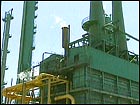|
U.S. factory orders drop
|
 |
January 8, 2002: 11:41 a.m. ET
Manufacturing slump continues, with orders falling after jump in October.
|
NEW YORK (CNN/Money) - Orders for goods made in U.S. factories fell in November, the government said Tuesday, as demand for military aircraft fell back to earth after a dramatic rise in October.
The Commerce Department reported that factory orders fell 3.3 percent in November to a seasonally adjusted $321.7 billion, compared with a 7.0 percent gain in October. Economists surveyed by Briefing.com expected orders to fall 2.6 percent.
"This report is certainly consistent with an economy that is trying to make a recovery, but a weak recovery," said Anthony Chan, chief economist at Banc One Investment Advisors. "When you start to back out the volatile components, it's not all that weak. We're picking it up, but these numbers tell us the economy will come back slowly."
Wall Street showed little reaction to the report, with U.S. stock prices mixed in morning trading and Treasury bond prices little changed.
The drop in orders was led by a 17.3 percent decline in orders for transportation equipment, the biggest drop since a 22.4 percent decline in January 2001.
|  | |
 |
 |
 |
| |
 CNNfn's Lisa Leiter reports on U.S. factory orders.
CNNfn's Lisa Leiter reports on U.S. factory orders.
| |
 |
A big -- and volatile -- component of transportation equipment, defense aircraft and parts, plunged 82.4 percent, the biggest drop since the department started keeping records in March 1992, but that followed a 492 percent jump in October.
Orders for other long-lasting goods, including cars, machinery, computers, appliances and furniture, increased. Still, factory orders excluding transportation equipment fell 0.2 percent, as orders for non-durable goods fell.
More encouragingly, inventories of durable goods fell 1.1 percent between October and November, while inventories of non-durable goods fell 0.6 percent. An overhang of unsold goods following a glut of production in the late 1990s has kept manufacturing in a slump, since companies won't make new goods until they get rid of their inventories.
Manufacturing has been in a recession for 17 months, according to monthly reports by the nation's purchasing managers, who, in their latest report, said the sector seemed poised for a rebound.
Manufacturing has lost more than a million jobs during its recession, blazing the trail for a recession in the broader U.S. economy.
To keep consumers spending despite an unemployment rate creeping towards 6.0 percent, the Federal Reserve cut its target for short-term interest rates 11 times in 2001, a record for a calendar year.
Observers are divided about whether the Fed will cut again after its next policy meeting, scheduled for Jan. 29-30, but most think they will leave rates unchanged and could even begin to raise rates later this year, if the economy seems healthy enough.
Click here for CNN/Money's economic calendar
Philadelphia Fed President Anthony Santomero, a voting member of the Fed's policy committee, said Tuesday that he expected a recovery by the middle of 2002.
"One reason for such confidence is our country has the biggest stimulus and lowest interest rates we have had for a very long time," Santomero said in a speech delivered to the Philadelphia Chamber of Commerce.
But Santomero also sounded cautious notes about the economy, saying businesses may take longer than usual to get rid of their excess inventories, consumer spending could suffer as unemployment rises, businesses already have too much unused technology and production equipment to buy more anytime soon, and the global economy is in recession.
"In short, a number of sectors will need to transition before we can be confident of an acceptable level of economic activity," Santomero said. "In the near term, we will be watching indicators like holiday retail sales, employment, consumer confidence, new orders in the manufacturing sector, foreign growth estimates and business inventory levels to see that recovery is on track." 
- from staff and wire reports
|
|
|
|
|
|

|

